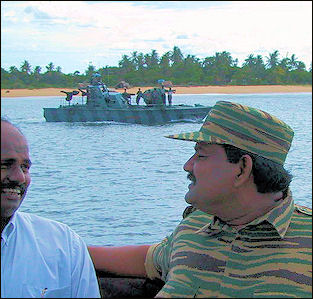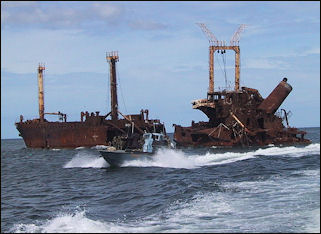TAMIL TIGERS
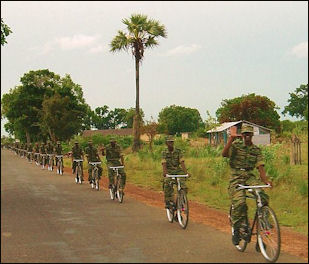
LTTE bike platoon north
of Killinochini May 2004 The Liberation Tigers of Tamil Eelam (LTTE) were an anti-Sinhalese separatist movement in Sri Lanka that has waged a war since 1983 against the Sri Lankan government in an effort to create an independent homeland for the Tamils in the north and east of Sri Lanka. The homeland would be called Eelam.
In the early 1970s, the LTTE was comprised of 26 fighters. It was one of several anti-government groups in Sri Lanka. They gained their position as the main insurgency group in Sri Lanka by allying themselves with other radicals, recruiting young peasants, brutalizing those who went against them and running a campaign of terror and assassination. After a massacre in 1983, thousands of new recruits joined the LTTE.
In the early and mid 1980s, the Tamil Tigers were armed and trained by India. In the early 1980s they competed with Marxist Tamil groups, also trained in India, for dominance. The Tigers emerged as the dominant group in the late 1980s when the Marxist groups lost credibility for supporting the presence of Indian security forces in northen Sri Lanka between 1987 and 1990.
In the 1990s and early 2000s the Tamil Tigers were regarded as one of the most tenacious, patient and stubborn insurgent movements in the world. Despite suffering huge losses, they remained strong, with high morale.
Pro Tamil Tigers Web site: TamilNet (www.tamilnet.com ). The Tamil Tiger website is Eelam Web (www.tamileelam.com ).
Sinhalese, Tamils and the Tamil Separatist Movement
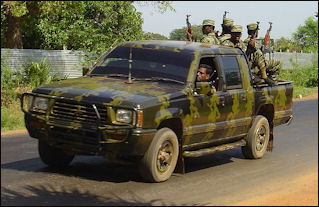
LTTE car with soldiers in
Killinochi April 2004 Buddhist Sinhalese (pronounced Singhalese) make up 74 percent of the population of Sri Lanka. Sometimes called Sinhalas or Singhalese, they speak the Sinhala language, live mostly in southwestern Sri Lanka and are predominately Theravada Buddhists. The name Sinhalese is derived from the term for “dwelling of the lions.” a reference to Sri Lanka’s mythical founder, an Indian princess who is said to have mated with a lion. The Sinhalese are in turn divided among the lowland Sinhalese (44 percent of Sri Lanka’s population) and Kandyan Sinhalese (31 percent.), who have traditionally lived in the highlands and hill country of southern central Sri Lanka.
The darker-skinned Hindu Tamils are the largest minority in Sri Lanka, making up 16 percent of the population . They live primarily in the north and east and the tea-growing areas of central Sri Lanka. Many are Hindus. The Tamils are divided in the Sri Lankan Tamils (9 percent of Sri Lanka’s population), whose descendants arrived many centuries ago, and the so-called Indian Tamils (8 percent), who were brought in by the British during the last 150 years to work the tea plantations.
In the 1970s and 80s various radical pro-Tamil groups began calling for the establishment of a Tamil homeland called Eelam. Many of the groups were militant youth groups made up of unemployed graduates and unmarried and rootless youths and were often led by a single charismatic leader. Some of the groups had strong Marxist beliefs.
The suicide tone of the movement was set when Pon Sivakumaran, a spokesman for young separatists in Jaffna, committed suicide in 1974 to avoid arrest. By 1984 a violence Tamil uprising had all but driven Sinhalese security forces out of the Tamil north and east. In May 1985, more than 150 people (mostly Sinhalese) were gunned down by terrorists in what became known as the Anuradhapura massacre.
Background of Sinhalese and Tamil Hostilities
Sea Tiger Colonel Soosai During the colonial period and the early years of Sri Lankan independence the Sinhalese and Tamils got along reasonably well or at least didn’t have any overt animosity towards one another. After independence in 1948, the Sinhalese felt that their greater numbers entitled them to more rights and powers. As time went on they began to resent the relatively egalitarian arrangement set up by the British. The relationship between the Sinhalese and Tamils began to disintegrate in 1956 when the Sinhalese used their numbers to elect Solomon W.R.D. Bandaranaike as prime minister. Bandaranaike was a populist who changed the careful balanced British policy to favor the Sinhalese.
Bandaranaike made Sinhala the official language of Sri Lanka and the language of the government and promised to give uneducated Sinhalese a more active role in the government. Tamils were required to learn Sinhalese and use it in schools rather than their own language. The British-educated Tamil government elite was thrown out in the cold. The "Sinhala only" policy placed Tamils in the position of quickly learning the Sinhalese or lose their the jobs. They resented this.
In 1958, Tamils took the street and thousands were killed during bloody riots when Sinhalese mobs attacks Tamils living in Sinhalese areas. One Sri Lankan man told National Geographic, "When we rejected English as our national language, we went from the solution to the problem."
The violence divided the Sinhalese and Tamils even further. The Tamils began calling for more autonomy and pushing for a federal arrangements that would give them more say in their own affairs. At the same time Sinhalese politicians began inflaming Sinhalese paranoia that their interests would be marginalized if the Tamils were given more power.
Discrimination Against Tamils
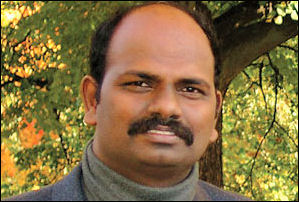
S Pulithevan For many decades, the Tamil workers who came from India to work the British plantations, and their descendants, were not even regarded as Sri Lankan citizens. In the early 1980s India decided to accept half of the 1.2 million Indian Tamils; the rest were granted Sri Lankan citizenship.
After the Bandaranaikes came to power the Sinhalese-dominated government denied Tamils jobs, services and access to education. A quota system was established in 1970 that guaranteed Sinhalese more university slots and jobs. In some cases, Tamils had their land seized by Sinhalese landlords. As Hindus the Tamils also resented a deceleration in the 1972 constitution that it was the duty of Sri Lankans to “protect and foster” Buddhism.
Quotas reduced Tamil access to higher education. Their numbers in the civil service were halved between 1970 and 1980 as Sinhala replaced English as the national language. These moves and high rate of unemployment radicalized Tamil youths.
Tamil Revolts
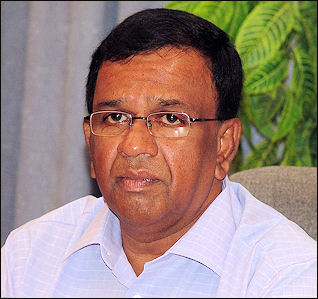
Balasingham Nadesan After riots by dissatisfied Sinhalese youth in 1971, the government set up job banks for them, redistributed land, and resettled many people from the crowded southwest to the sparsely populated north. The Tamils responded with their own revolt.
In April 1971 the government violently clamped down on an insurrection led by the pro-Tamil People's Liberation Front. As many as 15,000 people may have been killed. Some of the victims were forced to dig their own graves and then were lined in front of them and shot. Others were hung by their feet and tortured in front of crowds of people to set an example. Afterwards a state of emergency was declared in Tamil areas. Government forces sent to enforce it were regarded as undisciplined and corrupt. The Tamils resented their presence.
In 1974, Tamil political parties united and called for the establishment of a Tamil state in northen and eastern Sri Lanka through negotiations. The Sinhalese government made few concessions on the issue, hoping the Tamils would lose their will to keep pushing for change. But frustration among young Tamils only grew. They rejected compromising efforts by Tamil politicians and demanded more extreme measures be taken.
There were major Tamil revolts in 1977, 1981 and 1983. In 1977, Sinhalese mobs looted Tamil shops and homes and threw firebombs. More than a hundred people were killed. After this there were frequent clashes between Tamil “boys” and government security forces as well as series of tit-for-tat reprisal killings. Often innocent civilians were the victims.
In June 1981, Sinhalese police raided the Jaffna Public Library, one of the great repositories of Tamil culture, and set it one fire. Among the 97,000 volumes of material that were destroyed were rare of manuscripts written on palm leaves and stored in sandalwood boxes, miniature versions of the Ramayana and extinct Tamil-language newspapers. The attack was reportedly taken with the tacit support of cabinet ministers in Jaffna and was viewed as one episode in a cycle of revenge to retaliate for the killing of two police officers. It provoked widespread anger among Tamils and was a pivotal event.
Massacre in 1983
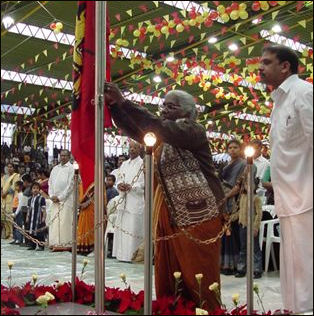
LTTE Memorial After the 1981 attack, many Tamils came to the conclusion that only the militant Tamil youth gangs could protect them. Hostilities escalated to war in July 1983, when Tamil separatists ambushed a Sri Lankan patrol, killing 13 soldiers in the Jaffna area. . Government-supported Sinhalese gangs went on a rampage for three days, looting, burning and attacking Tamils thoughout the country. At least 400 people were killed, most of them Tamils, including 53 Tamils held at Colombo's Welikade Prison and attacked by a mob. Some estimate 3,000 people were killed.
Many of the attacks were against Tamils in Sinhalese areas, particularly in Columbo and the hill country towns. "Tamils were not so easy to distinguish from Sinhalese," one Tamil intellectual told National Geographic. "The rioters would literally have to stop a man and ask his ethnicity. If they doubted he was Sinhalese they would make him recite a Buddhist text.” Government security forces and police did little to stop the violence and in some places were accused of participating in it.
The riots and violence effectively eliminated the Tamil business community in Columbo and other Sinhalese areas throughout Sri Lanka. There was a mass exodus of Tamils from Colombo and from Sri Lanka itself. All the moderate Tamil members of Parliament fled to India. Many Tamil intellectuals and members of the middle class fled abroad. This radicalized the Tamils even more and earned violent Tamil militants support among ordinary Tamils.
The massacre caused irreparable divisions between Sinhalese and Tamils. The riots set in motion a cycle of violence that has escalated over the years and triggered the Civil War with the Tamil Tigers.
Velupilla Prabhakaran
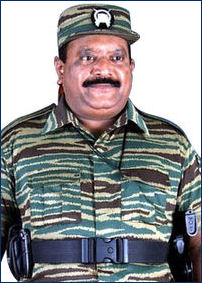
Velupilla Prabhakaran Velupilla Prabhakaran (also spelled Prabhakaran), the leader of the Tamil Tigers, was known for his ruthlessness and generally seen as Pol-Pot-like leader. The son a local government official, he was brought up near Jaffna and began his career as an insurgent commander at the age of 18 in 1972, when he formed a group called the Tamil New Tigers (TNT) after getting fed up with watching Sri Lankan police harass Tamil civilians. In 1976, he changed the groups name to the Liberation Tigers of Tamil Eelam.
Prabhakaran had a high, squeaky voice, and once studied to be a priest. He carried out his first murder, the assassination of a mayor of Jaffna, while he was still a teenager. He is regarded as a Robin-Hood-like figure among many of his supporters.
Prabhakaran rarely appeared in public and when he did it was only under heavy guard. "If you talk to many Sinhalese, they are in awe of the man," a psychiatrist told the New York Times. "They see him as almost super human. It’s a feature of the general sense of helplessness."
Pictures of Prabhakaran showed him with a bushy mustache, dressed in military fatigues, with a cyanide capsule tucked in his shirt pocket and a Browning pistol strapped to his waist . In the early 2000s he began appearing in a cream-colored safari suit as he attempted to recast himself as a political leader rather revolutionary commander.
Tamil Fighters and Their Rules and Code of Conduct
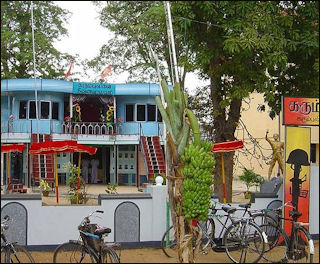
Black Tiger Commemoration At the height of the movement there were an estimated 10,000 to 15,000 Tamil Tiger fighters. Around that many Tamil Tiger fighters are believed to have died in battle. The fighters were trained and lived in a society that resembled a modern-day Sparta.
Tamil Tiger fighters wore a two-inch-long plastic vial of cyanide like a pendant around their neck and were instructed to put the vial and their mouth and bite down if captured or shot. It is estimated that hundreds of fighters committed suicide rather being taken prisoner by the government.
Officially no Tamil Tiger fighter worked or fought for pay. In the early- and mid-1980s manyTamil Tigers received training in India. The Indian government for a long time failed to clamp down on the training camps out of fear of alienating Tamil voters in southern India. Some Tigers received training by veterans of Yassar Arafat’s Palestinian Liberation Organization (PLO).
Tamil Tiger fighters followed a strict code of conduct that put a high premium on obedience and loyalty. Commanders that ventured too far from the party line sometimes were shot and killed.
Tamil Tiger fighters were prohibited from having sex, drinking alcohol, smoking and gambling. They were also required to change their name when they joined the group. Many were recruited from Tamil areas of Sri Lanka, where nearly every family contributed to the war effort.
Tamil Tiger fighters were originally not allowed to marry. But that rule was changed in 1985 after Prabhakaran fell in love with a young women who went and a hunger strike against the Sri Lankan government. The two were later married and after that fighters were allowed to marry when they retired after five years of combat.
Tamil Tiger Women Soldiers
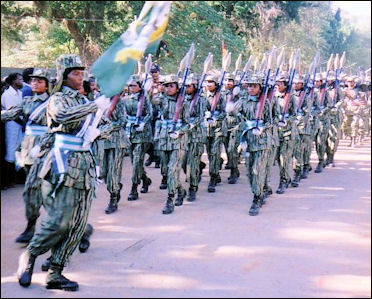
LTTE women fighters Women made up about a third of the Tiger fighting force. Tiger propaganda claimed the high number of women fighters indicated their commitment to equal rights. Skeptics disagreed. They pointed out the first woman fighter died in 1987, four years after the conflict began, and they didn't become a major presence until after thousands of men had died in battle, implying that women were sought as fighters primarily because so many male fighters died. [Source: Dexter Filkins, New York Times, March 6, 2000]
Women Tiger fighters attacked government police stations and bunkers, hacked men, women and children to death with knives and swords in villages raids and strapped explosives to their bodies in suicide bombing raids. Some 30 percent to 40 percent of the suicide bombers, including the one who killed Indian leader Rajiv Gandhi in 1991, have been women.
There were Tamil Tiger units made up completely of women. One attack by such a unit in 2001 — a raid on a government camp — killed 16 policemen. One woman Tiger fighter told the Los Angeles Times, she joined the Tigers after her brother was taken into custody by government soldiers and never seen again. "My brother was an innocent," she said. "I am fighting to avenge his death." She headed a unit of 1,500 women fighters. "It's difficult to say how many people I've killed. Sometimes after a battle there might be 50 or 70 bodies lying around. It's hard to say how many are mine.
TAMIL TIGERS TERRORISM
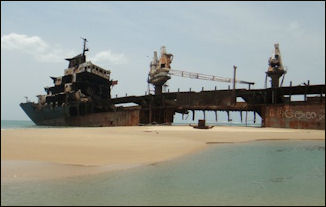
Farah III, boat destroyed
by LTTE suicide bombers The Tamil Tigers were formally outlawed as a terrorist group in the United States, India, Britain, Canada, and Australia. Prabhakran insisted that his group was not a “terrorist organization” but rather was a “liberation movement.” Targets of Tiger attacks and assassinations have included airliners, buses, oil depots, army camps and politicians. In many cases the filmed the attacks and used these films to motivate their fighters.
The Tigers rarely took credit for the bombings and assassinations that they were reported to have carried out but they usually left behind unmistakable clues that they were behind the attacks. When asked about Tiger culpability in the massacre of innocent civilians, senior Tiger commander Kariklan said, "If we wanted to kill innocent people, it would be easy for us; we could do it all the time. But we are not terrorists. We are a liberating force.”
One of the first terrorist-style attacks attributed to the Tamil Tigers was the bombing of an Air Lanka plane at Columbo airport in 1986 that killed16 people. The Tigers staged many of their attacks in July around the time of the anniversary of the 1983 massacre. The usual response by the Sri Lankan government to a Tiger attack was a bombing raid on a suspected Tamil Tigers camp in northern Sri Lanka.
Suicide Missions
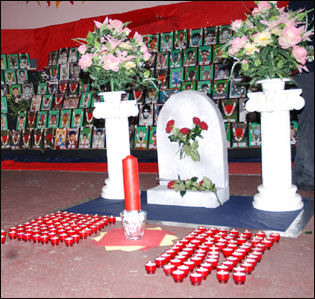
suicide bomber site memorial The Tamil Tigers have set off more suicide bombs than any other organization. As of 2002, by one count. they had carried 220 suicide bombing missions that killed , more 1,500 people. By contrast Hamas had set off 70 bombs at the same point in time. Rohan Gunaratna, an expert on terrorism at St. Andrews University in Scotland, told the New York Times, “of all the suicide capable terrorists we have studied they are the most ruthless and most disciplined.”
The Tamil Tigers are credited with popularizing the suicide mission as a military tactic. Suicide bombs had been used in isolated instances in the Middle East (most notably in the attack on the Marine barracks in Lebanon) but until the 1990s most attacks were car bombings or conventional ambushes or infiltrations. By contrast the Tamil Tigers used suicide bombing in a systematic way beginning in the late 1980s to fight an enemy that vastly out outnumbered them.
One Captain Millar is credited with being the first suicide bomber. In July 1987, he plowed a truck full of explosive into an army camp, killing 40 Sri Lankan soldiers. Others on suicide bombers carried out assassinations, bombed buildings and attacked ships. One even attacked Sri Lanka’s most scared Buddhist site, the Temple of the Tooth. To carry out the missions the Tigers have used men, women, children, animals, boats, motorized rickshaws, parcels, cars and trucks. Some have argued that the September 11th attacks have their roots in Tamil Tiger methods and tactics.
It is widely believed the Middle Eastern and militant Muslim groups such as Al-Qaida studied Tamil Tiger suicide missions. The attack on the Cole in Yemen by Al-Qaida in 2000 is believed to have been copied from Tamil Tiger attack on a Sri Lankan Navy ship in 1991. The Tigers also pioneered the use of sophisticated suicide body suits and surveillance techniques and developed methods to get close to targets.
The Tamil Tiger developed suicide mission as an offensive weapon. Ironically the main goal of suicide missions was to frustrate the military and the political leadership of the enemy with a minimum loss of life to the perpetrators (the loss of one suicide bomber is much less than losses sustained launching a military offensive). The word used to describe a Tamil Tiger suicide mission — “thatkodai” — means to “give yourself.” One Sri Lankan expert on the Tigers told the New York Times, “It is a gift of the self, self-immolation, or the self-gift. The person gives him or herself in full.”
Sri Lanka Tamils have traditionally had among the highest suicide rates in the world while Muslims traditionally haven’t had very high suicide rates.
Black Tiger Suicide Killer
Political assassinations and bombing in which the assassins blew themselves up along with their targets were a trademark of the LTTE. The suicide commandos that carried out these acts were members of an elite group known as the Black Tigers.

Black Tiger Picture Gallery 2004
By the mid 1990s about 36 Black Tiger had died on suicide mission, including terrorists who blew themselves up assassinating former Indian prime minister Rajiv Gandhi, Sri Lankan president Ranasinghe Premadas and presidential candidate Gamini Dissanayake. Captain Millar mentioned above is regarded as the first Black Tiger.
The Black Tigers usually had explosives sewn into special vests placed on their bodies. When the explosives were detonated their limbs were blown off and their heads went flying in the air. Black Tiger were also used on the battlefield. In attacks against well-dug-in positions that couldn’t be reached with mortars the Black Tigers hurled themselves in the bunker and detonated the explosives.
Little is known about how the Black Tigers were selected or trained. They are said to have volunteered and there was reportedly a waiting list of new recruits anxious to participate in the missions. A Tiger officer told National Geographic, "When a young person makes a decision to become a Black Tiger — to destroy himself — he goes through several training courses. It is his final act, and here is where the dedication of our young people is built. There is no liberation without sacrifice."
Black Tiger Martyrs
Those who died in suicide missions were applauded for their self sacrifice. This contrasts somewhat with the Muslim militants who volunteered because they were promised heavenly rewards as martyrs. "Our Black Tigers don't 'commit suicide' — they die a heroic death," a Tamil Tiger political official told National Geographic. "They know that they are going on an attack, and they are happy because it will change the military balance."

Black Tiger Picture Gallery 2004
Before the suicide commandos embarked on their missions they were are often honored at a special dinner with Prabhakaran, who reportedly was inspired by martyrdom themes in popular films and motivated by Tamil failure. One of his missions was to make teenagers believe that blowing themselves to bits was an honorable thing to do.
Posters of teenage Black Tigers who successful carried out their missions were posted in hospitals and schools in Tiger-controlled areas. Billboards with similar messages were posted around Tamil-Tiger controlled camps and towns. The Tiger administrative headquarters in Kilinochchi sold CDs and tribute songs to Black Tigers and DVDs of their exploits.
Huge monuments with paintings and pictures of fighters and suicide commandos — some as young as 14 — dominated intersections across Tamil-controlled areas of Sri Lanka. Monuments to the Black Tiger suicide commandos were especially large and ornate. Along the roadsides on highways in Tamil-controlled areas also were billboards that instructed women on how to play dead when injured and blow themselves up when government soldiers check to see if they were alive.
Suicide Navy Attacks
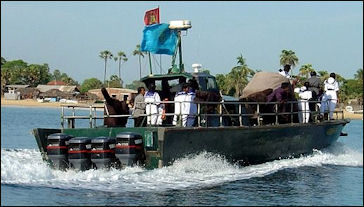
Sea Tiger Fast Attack boat Tamil Tiger suicide attackers, known as the Sea Tigers, were quite effective attacking ships. They destroyed a third of the Sri Lankan Navy and attacked oil tankers.
In September 1994 a 330-ton, 130-foot-long government patrol boat, the largest warship in the Sri Lankan navy, was sunk by suicide attack from speedboats disguised as fishing vessels and packed with explosives. One of the speedboats rammed the bow and 22 of the 40 sailors on board were killed. [Source: John Ward Anderson, Washington Post, February 4, 1995]
One of the four Black Tigers who died during the suicide attack on the Sri Lankan naval vessel was 22-year-old Pathmavathy Arumutasamy. Her father told the Washington Post: "We were surprised when we heard there was an attack and our daughter met with heroic death. As a father I am sad about it , but at the same time, I'm proud and happy she made the supreme sacrifice."
In April 1995, four Black Tigers — two girls and two boys — detonated explosives that sunk two of the Sri Lankan navy's eight Chinese-built gunboats and took the lives of 12 Sri Lankan soldiers. Before leaving on their suicide mission, the four "Sea Tigers," had dinner with Prabhakaran and a memorial photograph was taken with him.
Tamil Tiger Bombings
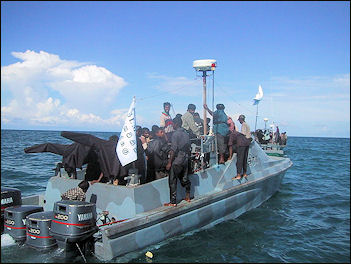
Sea Tigers cadre transport In January 1996, a huge bomb exploded in downtown Colombo, killing 91 people and injuring 300. The 400-pound bomb was planted in a truck that was rammed into the Central Bank in downtown Colombo, near the World Trade Center, Columbo’s tallest building. When security personal moved in on the truck, three people burst from the truck and began shooting in all directions. Prabhakaran was later sentenced in absentia to 200 years in prison for planning the bombing.
In October, 1997, a truck bomb packed with a half ton of explosives blew up in the central business district of Columbo near three five-star hotels frequented by foreigners and near the World Trade Center. Eighteen people were killed but none of them were foreigners. The attacks were believed to have been a Tiger retaliation to being included on United States State Department list of terrorist organization, which had the potential of hurting the Tigers ability to raise funds from Tamils living overseas. Among the 100 or so injured were people from Britain, France, Japan, Singapore, Jordan, Australia, Canada, Cuba, Egypt, India, the Netherlands, South Korea, Lebanon, Malaysia, Pakistan, Saudi Arabia and Sweden. Most of injured were hurt by flying glass.
Sri Lanka's most important Buddhist temple, Dalada Maligawa (the "Temple of the Tooth") in Kandy was bombed in January 1998. In May 2000, four Tamil Tiger revels killed themselves after the failed in attempt to kill the defense monitors and three chiefs of the armed forces by attacking their motorcade. The rebels killed themselves as police were preparing to storm the apartment where they were hiding out. In October 2000, 19 people were killed during a suicide bombing before parliamentary elections in Muttar (150 miles east of Colombo).
Thirty-two people were killed and 300 were injured when a bus packed with two powerful bombs blew up outside a crowded train station. Many of the dead were children. The bombs were believed to have been detonated by the driver of the bus, who was killed in the attack. At least 21 people were killed, including a government minister, and at least 60 were injured during a suicide bomb attack near the airport in Colombo. A suicide bomber blew himself up during a procession by the ruling party.
Assassinations by the Tamil Tigers
freigher sunk by Sea Tigers Over the years a Sri Lankan president, a former Sri Lankan prime minister, an opposition political leader, a minister of defense, four other cabinet ministers, and various generals and politicians have been assassinated in Sri Lanka. Many of these were carried out by the Tamil Tigers. Others were carried out by other groups.
Sri Lankan President Ranasinghe Premadasa was killed by a Tamil Tiger on May 1, 1993 by a suicide bomber who rammed his bicycle into the presidential party stand during a May Day parade. Twenty three others were killed.
In October 1994, 52-year-old presidential candidate Gamini Dissanyake had just told a crowd goodbye when a young woman with braided hair positioned herself 10 feet from the platform where he spoke and detonated a bomb beneath her T-shirt. Packed with ten pounds of ball bearings, the bomb killed 54 people and wounded more than 100. Among the dead were three former cabinet ministers and several wives and daughters of leading figures. The head of the unidentified suicide bomber was found more than 80 feet away on a second story rooftop.
Moderate Tamil politicians who spoke out against the Tigers have been assassinated. One such politician, Neeelan Tiruchelvam, was killed when a suicide bomber approached his car while it was stuck in Colombo traffic. Tiruchelvam was blown out of the car. The head of the suicide bomber flew over several cars and landed next to a car.
Assassination of Rajiv Gandhi
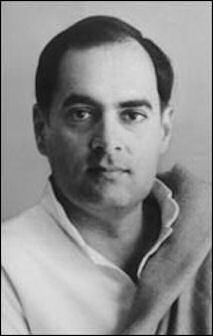
Rajiv Gandhi Rajiv Gandhi was killed on May 21, 1991 in the southern temple town of Sriperumbudur in Tamil Nadu just as he was ready to begin a political rally in southern India in an effort to regain the office of Prime Minister. The bomb that killed him contained one pound of RDX plastic explosive and was packed with 10,000 metal pellets. Seventeen people, including nine policemen were killed, along with Gandhi. The partial head of the assassin was found on the grass near where Gandhi was killed.
The bomb was strapped to the body of a female suicide commando who working for the Liberation Tigers if Tamil Eelam (LTTE), the pro-Tamil terrorist group in Sri Lanka. The bomb exploded as the assassin went to shake Gandhi's hand and offer him flowers. In 1987, Gandhi sent troops to disarm the Tigers under an agreement with the Sri Lankan government. The troops were withdrawn in 1990 but that didn’t stop the Tigers from getting revenge by assassinating Rajiv.
In 1998, 16 Sri Lankan and 10 Indians were sentenced to hang for conspiring or playing a part in the assassination. Only two were directly involved in the murder, including the man who built the bomb. The rest were charged with lesser charges such as conspiracy, for helping the killers by providing transportation, housing or food. The trial lasted for five years, compared to two years for the killer of Mahatma Gandhi and 15 months for the killer Indira Gandhi.
Combating Terrorism in Sri Lanka
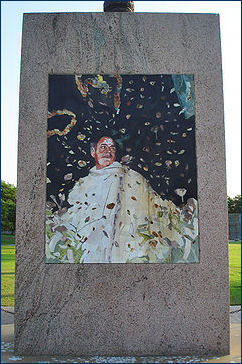
Rajiv Gandhi
Memorial bombsite In their battle against terrorism police in Colombo did spot checks on cars and owners and set up road blocks to check vehicles coming into the city for weapons. Citizens seem willing to put up with inconveniences and hassles, One Colombo resident told National Geographic, "Unless we all cooperate at the checkpoints, they will strike again in no time."
Motorized rickshaws have been banned from getting too close to buildings out of fear they might be carrying gunmen or packed with explosives.
Ultimately the government realized it could do little to stop the suicide bombers themselves and that the only way to end the bombings was to negotiate with the Tamil Tigers since they were ones who supported the bombers and they were the ones who could stop them.
Image Sources: Wikimedia Commons
Text Sources: New York Times, Washington Post, Los Angeles Times, Times of London, The Guardian, National Geographic, The New Yorker, Time, Newsweek, Reuters, AP, AFP, Wall Street Journal, The Atlantic Monthly, The Economist, Global Viewpoint (Christian Science Monitor), Foreign Policy, Wikipedia, BBC, CNN, NBC News, Fox News and various books and other publications.
Last updated July 2012

